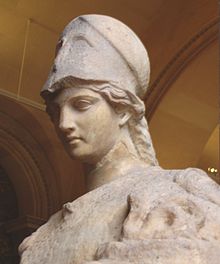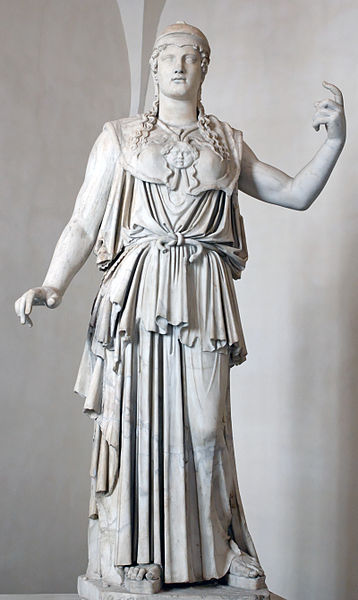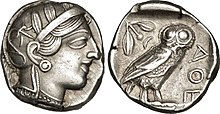|
Greek city of Pharsalos in Thessaly
Bronze Tetrachalkon 22mm, (7.76 grams)
Struck
Late 5th-mid 4th century BC.
Reference: Cf. Lavva 308-14 (uncertain
dies); Rogers 502 var. (arrangement of ethnic).
Head of Athena Parthenos facing slightly left, wearing triple-crested
helmet, holding spear and shield
Thessalian horseman
right, brandishing flail at enemy soldier fleeing to right; behind horseman,
soldier walking right with staff over his shoulder.
One of the more important towns of Thessaly, Pharsalos was
built on the northern slopes of Mt. Narthakios. It was the scene of Caesar’s
famous victory over Pompey in 48 B.C.
You are bidding on the exact item pictured,
provided with a Certificate of Authenticity and Lifetime Guarantee of
Authenticity.
Farsala (Greek:
Φάρσαλα), known in Antiquity as
Φάρσαλος
, Pharsalos or Pharsalus,
is a city in southern
Thessaly
, in
Greece
. Farsala is located in the southern part
of
Larissa Prefecture
, and is one of its largest
cities. The city is linked with
GR-3
, the old highway linking
Larissa
and
Lamia
and is also accessed by
GR-30
linking
Karditsa
and
Volos
. The
GR-1
/E65
and
E75
superhighway runs to the east of the city.
Several mountain ranges lie to the South, while the
Thessalian Plain
lies to the North, some hills
to the East and the Farsalian Fields in the central part. Farsala is located SE
of Karditsa
, S of
Larissa
, W of
Volos
and N of
Lamia
.
The area is an economic and agricultural centre of the province. The
population are mainly rural especially with
cotton
production and breeding, one of the many
are in local production units in agricultural production as well as clothing and
textile industries. Farsala is famous for its distinctive
halva
. The population (2006) is about 13,500.
The population in 1981 was 7,094, in 1991 8,413 and in 2001 9,801.
//
Ancient Pharsalos
The Homeric Phthia
of the
Mycenaean
period, capital of the Kingdom of the
Myrmidons
and of
Peleus
, father of
Achilles
, has sometimes been identified with
the later city of Farsalos (Greek: Φάρσαλος), now Pharsala. A
Cyclopean Wall
which protected a city still
exists today near modern Pharsala, as does a vaulted tomb from that period.
The Pharsalos of the historic era was built over a hillside of the Narthacius
mountains at an elevation of some 160 m, where modern Pharsala stands. It was
one of the main cities in Thessaly and was the capital of the Phthian
tetrarch
. In the
Persian Wars
it sided with the
Athenians
. A distinctive tribe of the city was
that of Echecratidon. In the early-4th
century BC, the city was a part of the Thessalian Commons. Later, it
joined the
Macedonian Kingdom
under
Philip II
. The area became a theatre of war
where the Aetolians and the Thessalians clashed with the Macedonians, especially
during the
Second
and the
Third Macedonian Wars
. After the defeat of the
Macedonian Kingdom, Pharsalos and the whole area became a part of the
Roman Republic
. The whole area suffered great
destruction during the
Roman Civil War
. The
Battle of Pharsalus
took place in 48 BC in the
fields of the Pharsalian Plain, where
Julius Caesar
defeated
Pompey
.
The geographer Strabo speaks of two towns, Old Pharsalos (Palaepharsalos) and
Pharsalos, existing in historical times. His statement (9.5.6) that the
Thetideion, the temple to Thetis south of Skotoussa, was “near both the
Pharsaloi, the Old and the New”, seems to imply that Palaepharsalos was not
itself close by Pharsalos. Although the battle of 48 BC is called after
Pharsalos, four ancient writers – the author of the Bellum Alexandrinum
(48.1), Frontinus (Strategemata 2.3.22), Eutropius (20), and Orosius
(6.15.27) – place it specifically at Palaepharsalos. In 198 B.C. Philip V
had sacked Palaepharsalos (Livy 32.13.9). If that town had been close to
Pharsalos he would have sacked both, and Livy would have written “Pharsalus”
instead of “Palaepharsalus”. The British scholar
F. L. Lucas
demonstrated (Annual of the
British School at Athens, No. XXIV,
1919-21) that the battle of 48 BC must have been fought north of the
Enipeus, near modern-day Krini; and John D. Morgan in “Palae-pharsalus – the
Battle and the Town” (The American Journal of Archaeology, Vol. 87, No.
1, Jan. 1983), suggests that Krini is built on the site of Palaepharsalos, where
the old road south from Larissa emerged from the hills on to the Pharsalian
Plain.

Helmeted Athena with the cista and Erichthonius in his serpent form.
Roman, first century (Louvre
Museum)
In
Greek religion
and
mythology
, Athena or Athene, also
referred to as Pallas Athena/Athene , is the goddess of wisdom, courage,
inspiration, civilization, law and justice, just warfare, mathematics, strength,
strategy, the arts, crafts, and skill.
Minerva
is the
Roman goddess
identified with
Athena.

Athena is also a shrewd companion of
heroes and is the
goddess
of heroic endeavour. She is the
virgin
patroness of
Athens
. The Athenians founded the
Parthenon
on the Acropolis of her namesake
city, Athens (Athena Parthenos), in her honour.
Athena’s veneration as the patron of Athens seems to have existed from the
earliest times, and was so persistent that archaic myths about her were recast
to adapt to cultural changes. In her role as a protector of the city (polis),
many people throughout the Greek world worshiped Athena as Athena Polias
(Ἀθηνᾶ Πολιάς “Athena of the city”). The city of
Athens
and the goddess Athena essentially bear
the same name,
“Athenai” meaning “[many] Athenas”.
Patroness

Athenian
tetradrachm
representing the
goddess Athena
Athena as the goddess of philosophy became an aspect of the cult in Classical
Greece during the late 5th century B.C. She is the patroness of various crafts, especially of
weaving
, as Athena Ergane, and was
honored as such at festivals such as
Chalceia
. The metalwork of weapons also fell
under her patronage. She led battles (Athena
Promachos or the warrior maiden Athena Parthenos)
as the disciplined, strategic side of war, in contrast to her brother
Ares, the patron of violence, bloodlust and slaughter—”the raw force
of war”.
Athena’s wisdom includes the cunning intelligence (metis) of such figures
as Odysseus
. Not only was this version of Athena
the opposite of Ares in combat, it was also the polar opposite of the serene
earth goddess version of the deity, Athena Polias.
Athena appears in Greek mythology as the patron and helper of many heroes,
including Odysseus
,
Jason
, and
Heracles
. In
Classical Greek
myths, she never consorts with
a lover, nor does she ever marry,earning the title Athena Parthenos. A remnant of archaic myth depicts her
as the adoptive mother of
Erechtheus
/Erichthonius
through the foiled rape by
Hephaestus
.
Other variants relate that Erichthonius, the serpent that accompanied Athena,
was born to
Gaia
: when the rape failed, the semen landed on
Gaia and impregnated her. After Erechthonius was born, Gaia gave him to Athena.
Though Athena is a goddess of war strategy, she disliked fighting
without
purpose and preferred to use wisdom to settle predicaments.The goddess
only encouraged fighting for a reasonable cause or to resolve
conflict. As patron of Athens she fought in the Trojan war on the side
of the
Achaeans.
Mythology
Lady of Athens
Athena competed with
Poseidon
to be the patron deity of Athens,
which was yet unnamed, in a version of one
founding myth
. They agreed that each would give
the Athenians one gift and that the Athenians would choose the gift they
preferred. Poseidon struck the ground with his
trident
and a salt water spring sprang up; this
gave them a means of trade and water—Athens at its height was a significant sea
power, defeating the
Persian
fleet at the
Battle of Salamis
—but the water was salty and
not very good for drinking.
Athena, however, offered them the first domesticated
olive tree
. The Athenians (or their king,
Cecrops
) accepted the olive tree and with it
the patronage of Athena, for the olive tree brought wood, oil, and food.
Robert Graves
was of the opinion that
“Poseidon’s attempts to take possession of certain cities are political myths”
which reflect the conflict between matriarchal and patriarchal religions.
Other sites of cult
Athena also was the patron goddess of several other Greek cities, notably
Sparta, where the archaic cult of
Athena Alea
had its sanctuaries in the
surrounding villages of
Mantineia
and, notably,
Tegea
. In Sparta itself, the temple of Athena
Khalkíoikos (Athena “of the Brazen House”, often
latinized
as Chalcioecus) was the
grandest and located on the Spartan acropolis; presumably it had a roof of
bronze. The forecourt of the Brazen House was the place where the most solemn
religious functions in Sparta took place.
Tegea was an important religious center of ancient Greece,
containing the Temple of
Athena Alea
. The temenos was founded by
Aleus
,
Pausanias
was informed.
Votive bronzes at the site from the Geometric and Archaic periods take the forms
of horses and deer; there are
sealstone
and
fibulae
. In the Archaic period the nine
villages that underlie Tegea banded together in a
synoecism
to form one city.
Tegea was listed in Homer
‘s
Catalogue of Ships
as one of the cities that
contributed ships and men for the
Achaean assault on Troy
.
Judgment of Paris

Aphrodite is being surveyed by Paris, while Athena (the leftmost
figure) and Hera stand nearby.
El Juicio de Paris
by
Enrique Simonet
, ca. 1904
All the gods and goddesses as well as various mortals were invited to the
marriage of Peleus
and
Thetis
(the eventual parents of
Achilles
). Only
Eris
, goddess of discord, was not invited. She
was annoyed at this, so she arrived with a golden apple inscribed with the word
καλλίστῃ (kallistēi, “for the fairest”), which she threw among the goddesses.
Aphrodite, Hera, and Athena all claimed to be the fairest, and thus the rightful
owner of the apple.
The goddesses chose to place the matter before Zeus, who, not wanting to
favor one of the goddesses, put the choice into the hands of Paris, a
Trojan prince. After bathing in the spring of
Mount Ida
(where Troy was situated), the
goddesses appeared before Paris. The goddesses undressed and presented
themselves to Paris naked, either at his request or for the sake of winning.

Paris is awarding the apple to Aphrodite, while Athena makes a face.
Urteil des Paris by
Anton Raphael Mengs
, ca. 1757
Still, Paris could not decide, as all three were ideally beautiful, so they
resorted to bribes. Hera tried to bribe Paris with control over all
Asia and Europe
, while Athena offered wisdom, fame and
glory in battle, but Aphrodite came forth and whispered to Paris that if he were
to choose her as the fairest he would have the most beautiful mortal woman in
the world as a wife, and he accordingly chose her. This woman was
Helen
, who was, unfortunately for Paris,
already married to King
Menelaus
of
Sparta
. The other two goddesses were enraged by
this and through Helen’s abduction by Paris they brought about the
Trojan War
.

The Parthenon
, Temple of Athena
Parthenos
Masculinity and
feminism
Athena had an “androgynous compromise” that allowed her traits and what she
stood for to be attributed to male and female rulers alike over the course of
history (such as Marie de’ Medici, Anne of Austria, Christina of Sweden, and
Catherine the Great)
J.J. Bachofen advocated that Athena was originally a maternal figure stable
in her security and poise but was caught up and perverted by a patriarchal
society; this was especially the case in Athens. The goddess adapted but could
very easily be seen as a god. He viewed it as “motherless paternity in the place
of fatherless maternity” where once altered, Athena’s character was to be
crystallized as that of a patriarch.
Whereas Bachofen saw the switch to paternity on Athena’s behalf as an
increase of power, Freud on the contrary perceived Athena as an “original mother
goddess divested of her power”. In this interpretation, Athena was demoted to be
only Zeus’s daughter, never allowed the expression of motherhood. Still more
different from Bachofen’s perspective is the lack of role permanency in Freud’s
view: Freud held that time and differing cultures would mold Athena to stand for
what was necessary to them.
|














